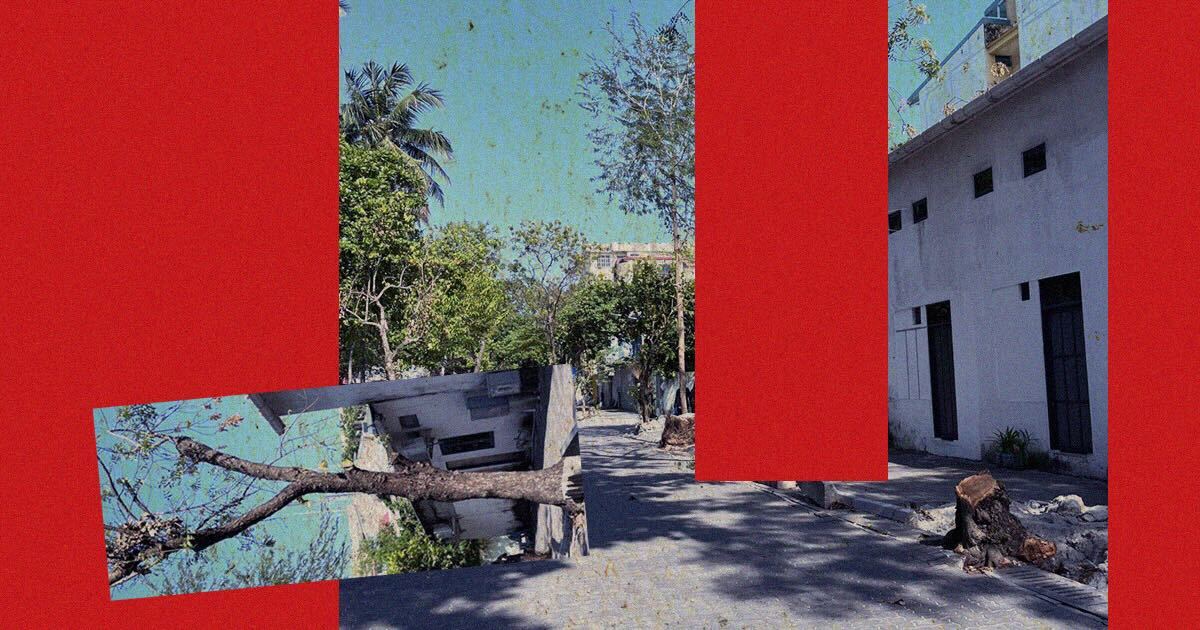An irresponsible “solution”: Malé City Council’s obsession with uprooting trees
Where shade once stood, only sun-baked concrete remains.

Artwork: Dosain
27 Mar, 7:41 PM
It was the third day of this blessed Ramadan when my phone began buzzing with calls and messages. The question on everyone’s mind was simple: who from the Malé City Council decided to remove mature trees lining both sides of the road, when was this decision made, and why? This was the first I had heard of it. The city council had not made any decision to cut down and clear away any large trees.
Council members, it’s worth noting, do not have enforcement, organisational, or administrative powers. These executive powers, along with discretionary authority over daily decision-making, rest with the mayor. The secretary general oversees the administrative management of the office.
In this case, however, I only discovered what had actually occurred after scrolling through X (formerly Twitter). Evidently, decades-old trees in Vilimalé had been cut down and leveled. Social media users posted before-and-after photos of the area. Where lush branches and leaves once offered cool breezes and shade, all that remained was the stark sight of roads and sidewalks exposed to the sun’s unforgiving heat.
Frustrated, I immediately took to the council's official WhatsApp group to express my concerns. I asked the mayor why, even if pruning was necessary, every single tree on both sides of the road had to be cut and levelled down to the base.
Mayor Adam Azim responded, stating that because the rows for Tarawih prayers extended outside the mosque during Ramadan, they obstructed the MTCC buses from using the road. As a result, he explained, the city had no choice but to remove the trees in order to clear the new bus route, as requested by MTCC.
This logic was deeply troubling. The mayor saw nothing wrong with cutting down and disposing of trees that had stood for twenty or thirty years, all to make way for buses running for just one month. It was clear from his response that he viewed this as a perfectly logical decision. This mentality, unfortunately, is reflective of the mindset of those responsible for managing Malé’s urban landscape.
The people running Malé do not know how to grow trees. They only know how to cut them down. In an overcrowded, concrete urban setting like Malé, cultivating trees requires far more than just watering. In urban environments, specific techniques are required to manage and maintain mature trees. They do not grow wild and unmanaged.
Unfortunately, the policy in Malé has been to allow trees to grow however they will. Nothing is done to control the excessive spread of roots and branches. There is no oversight or active management. The city does not regularly trim branches, train roots, or correct curvatures in trunks.
This neglect leads to trees becoming liabilities. Roads, sidewalks, and walls adjacent to unmanaged trees get undermined, cracked, and broken. When the trees reach a mature age, the response is simple: remove them.
At this point, any complaints from the public are met with a predictable response – an ad-hoc, three-day tree planting media event is organised to counter any dissenting voices.
This is the easy, cheap approach – especially in the absence of standard operating procedures (SOPs) or restrictions governing tree management.
Adding to the problem is the lack of transparency regarding the city’s vegetation. Local councils are legally required to count, list, and publicise all trees and plants within their jurisdiction, but the Malé City Council has failed to do so. There is no record of cut trees, dead trees, planted trees, or even the number of trees of a particular species. I believe this lack of tracking and information enables tree-cutting whenever it’s deemed convenient.
In modern times, growing trees and landscaping has become a specialised profession, one that requires expertise in horticulture and urban ecology. Sadly, people with this knowledge are not part of the city council’s permanent staff. Horticulturists and landscapers are not recognised within the civil service framework.
However, this is no excuse for continuing the reckless practice of indiscriminately cutting down trees. When the city council needs experts for tasks outside its permanent structure, they hire consultants. The mayor, for instance, employs around twenty-five people on a consultative basis. Just for media-related tasks such as photography, video editing, writing reports, and managing public relations, he employs around seven people. Their positions and salaries would likely shock many.
So why can’t the same approach be taken for hiring professionals who specialise in urban landscaping, planting, and tree maintenance? The answer is clear: it’s simply not considered important. There is no value or affection for nature and the environment within the current system.
This lack of respect for nature is not just limited to trees. Human dignity extends to the living, but it also, theoretically, extends to the dead. The bones, flesh, graves, and memories of those who have passed are revered and respected. Yet, in the name of “development,” even human graves in the Maafannu cemetery are being removed and discarded.
So, if we can discard human graves for the sake of progress, what’s the harm in cutting down a 20-year-old tree?
"There is serious public concern over the cutting of old trees in Vilimalé. Apparently the trees are being cut because of difficulties for the bus route. Is there no other way?"
"Cutting down trees grown on the roads of Malé at the whim of the [Malé City Council] is done against the law. I believe that criminal charges should be raised against that council over this."
"The planting of 70 fruit trees and 60 flowering trees in empty tree pits in Vilimalé.'
"Vilimalé is the lung that creates oxygen for the residents of Fura-Malé."
Mohamed Saif Fathih represents the Galolhu North constituency in the Malé City Council.
All comment pieces are the sole view of the author and do not reflect the editorial policy of the Maldives Independent. If you would like to write an opinion piece, please send proposals to editorial@maldivesindependent.com.
Discussion
No comments yet. Be the first to share your thoughts!
No comments yet. Be the first to join the conversation!
Join the Conversation
Sign in to share your thoughts under an alias and take part in the discussion. Independent journalism thrives on open, respectful debate — your voice matters.




